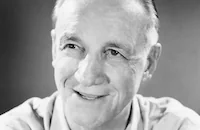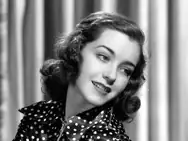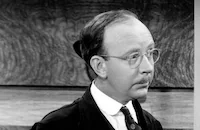The Inside Story

Brief Synopsis
Cast & Crew
Allan Dwan
Marsha Hunt
William Lundigan
Charles Winninger
Gail Patrick
Gene Lockhart
Film Details
Technical Specs

Synopsis
At the Silver Creek National Bank in post-Depression Vermont, a man known as "Uncle Ed" sees a fellow bank customer, Mason, placing a large sum of cash inside his safety deposit box. Ed decides to tell Mason the story of $1,000 and how it helped a lot of people: During a bank holiday in the fourth year of the Depression, Ed works for an innkeeper named Horace Taylor. One day, Horace's supplier, Jay Jay Johnson, refuses to send him any more supplies for the inn dining room until he pays his outstanding balance. Horace, meanwhile, hopes to collect $900 in back rent from his daughter Francine's sweetheart, Waldo Williams, an artist who is also a guest at the inn. Waldo soon learns, however, that a buyer who had commissioned a painting from him has committed suicide after losing his fortune in the stock market. Back at the inn, guest Eustace Peabody, a New York City art collector, asks Ed to hold $1,000 for Ab Follansbee, whose wife is expecting. Ed quickly stashes the money in the inn's safe, while two gangsters lurk in the dining room. When Francine tries to convince wealthy Geraldine Atherton to sit for a portrait painting, she explains that Johnson owes her three months rent. After Geraldine learns that Tom O'Connor is likely to lose his law practice for lack of clients, she asks him to draft a writ to evict Johnson. In Waldo's room at the inn, Tom's wife Audrey then tells Waldo that she will not be able to pay for the portrait that he has been working on. After threatening to close the inn, Johnson demands that Horace give him the $1,000 that he knows is in the safe. When Horace finds it there, he assumes that the money is payment for one of Waldo's paintings and gladly gives it to Johnson. Johnson pays Geraldine, who then gives the money to Tom as a retainer fee. When Horace learns that the money actually belongs to Ab, he rushes to retrieve it from Johnson, but is too late. He returns to the inn and demands that Waldo leave immediately. After Tom takes the money to Audrey, Peabody returns to retrieve it from the safe, so in order to stall for time, Horace says that he does not know the combination. Ed asks the gangsters to watch the desk, but they crack the safe instead. When Tom learns that Audrey was seen entering Waldo's room at the inn, he assumes that they are having an affair. He rushes in and punches Waldo in the face, but then realizes that she is only posing for her portrait. With the painting complete, Audrey pays Waldo, who rushes to Horace with the money. When Ab, now the proud father of twins, arrives to collect his money, Horace finally pays him. Thanks to Ed's story, Mason is convinced that the best place for his cash is in circulation.

Director

Allan Dwan
Cast

Marsha Hunt

William Lundigan

Charles Winninger

Gail Patrick

Gene Lockhart

Florence Bates

Hobart Cavanaugh

Allen Jenkins
Roscoe Karns

Robert Shayne

Will Wright
Wm. Haade
Tom Fadden

Frank Ferguson
Garry Owen

James Kirkwood
Rodney Bell
Crew
Victor B. Appel
Frank Arrigo
Allan Dwan
Peggy Gray
John Grubbs
Virgil Hart
Geza Herczeg
Herb Kirkpatrick
Reggie Lanning
Ernest Lehman
Mary Loos
Mickey Marigold
Bob Mark
Nils Mathias
John Mccarthy Jr.
George Milo
Adele Palmer
Arthur Roberts
Richard Sale
Morton Scott
Nathan Scott
Howard Wilson
Dorothy Yutzi

Film Details
Technical Specs

Articles
The Inside Story
While Ford called Twentieth Century-Fox home and DeMille was ensconced at Paramount, Dwan was not associated with one major studio. In the silent era, he worked at several studios, including Essanay, Universal and Paramount, where he directed Gloria Swanson in eight films. When sound caught the industry off guard, and studios struggled to convert their production facilities to sound stages, Dwan landed at Fox. Despite his experience, the veteran director was relegated to Fox's B-movie unit. In September 1945, Dwan signed with Republic Pictures, the legendary Poverty Row studio that specialized in low-budget movies, series and serials. On the surface, his decision to work for a low-rent studio may seem like a step down, considering his status as a Hollywood insider and veteran director. But there was more to Republic at that time than its reputation for B-movie fare.
Republic was created in 1935 when Herbert J. Yates united several struggling Poverty Row production companies into one studio. Yates sought to cash in on the rise of the double feature in theaters. Republic produced and distributed Westerns, serials and low-budget genre movies designed to share a double bill with A-budget films from the major studios. The studio's top star was singing cowboy Gene Autry, who headlined a series of low budget, hour-long, modern-day Westerns. That's the Republic that comes to mind for most classic film fans whenever the studio is mentioned.
However, during World War II, Yates saw profits soar at Republic and he decided to venture into making A-budget movies. Republic didn't abandon its low-budget fare, but it extended its output to include films that Yates considered to be prestigious. He organized the studio's offerings into four categories--Jubilee, Anniversary, Deluxe and Premiere. Jubilee movies included the Westerns with singing cowboys Autry and Roy Rogers. Anniversary films had slightly longer shooting schedules and bigger budgets, and Deluxe fare doubled the budgets and schedules of Anniversary movies. His Premiere features had budgets comparable to those of the major studios and were intended to compete with other films of its stature. Republic produced two to three Premieres per year. Yates hired the best directors for his Premiere films, including John Ford, Fritz Lang, Frank Borzage, Orson Welles and Allan Dwan.
Dwan received $1,000 per week, plus 5% of the net. More importantly, he was given the right to be credited as an associate producer on his films. He directed his first film for Republic, Rendezvous with Annie, in 1946. An intricate character comedy, the film ranks as one of his best in that genre. A high point in Republic's venture into A-budget films was Dwan's 1949 war drama Sands of Iwo Jima, starring John Wayne. It was the only Republic title to make it into the top five grossing films for a given year.
The Inside Story, released in 1948, is a warm-hearted comedy of errors starring Marsha Hunt and William Lundigan. The cast was rounded out by a selection of talented character actors familiar to most moviegoers. The Inside Story is set in a small town in Vermont during the bank holiday of 1933, in which banks were closed by the government to avoid hordes of panicked people withdrawing all of their money, thus destabilizing an already fragile economy. The story revolves around six residents in various financial predicaments, who accidentally get access to $1,000 meant for someone else. The money had been placed in the safe of the local inn. However, when innkeeper Horace Taylor (Gene Lockhart) finds it, he believes it is payments owed to him from his debtors. He pays off his own debts but learns from Uncle Ed (Charles Winninger) that the money belonged to a guest at the inn. Horace frantically searches for the money, which is rapidly circulating around town. Also searching for the dough are two hapless bootleggers.
According to Allan Dwan and the Rise and Decline of the Hollywood Studios, the definitive biography by Frederic Lombardi, Dwan was a sensitive director in regard to his actors. Many of his films featured large casts that included prominent stars and notable character actors, and Dwan guided them with assurance, especially in comedies. The Inside Story includes two strong female characters--Francine (Hunt), the feisty daughter of innkeeper Horace Taylor and Audrey O'Connor (Gail Patrick), a devoted wife forced to support her family when her husband cannot find work. Interestingly, the women characters in the story, including local mill owner Geraldine Atherton, are the movers and shakers in the town. Because of the Depression and the lack of work and opportunity, the male characters, such as artist Bill Williams (William Lundigan) and Audrey's husband Tom (Robert Shayne), are stagnating. Gail Patrick, in her last feature film, played a softer character than her usual haughty socialites, scheming vixens or "other women" that were her forte at the major studios. Gifted actress Marsha Hunt starred as Francine. Hunt would appear in only one more film before falling victim to McCarthyism and the Blacklist, which curtailed her stardom. Though she appeared in episodes of various television series, she turned her energies to humanitarian causes during the 1950s and 1960s.
Like many films from the classic era, The Inside Story was invigorated by the performances of recognizable character actors. Florence Bates, who built her career on playing colorful matrons, co-stars as the wise-cracking Geraldine Atherton. Roscoe Karns played the insurance agent who is responsible for the money and Allen Jenkins mugged his way through his role as a gangster.
Allan Dwan was the consummate studio director, meaning his choice of visual techniques serviced the story or characters. His unpretentious, invisible editing advanced the narratives of his films in a clear, clean way. Each shot was a calculated part of the narrative structure, rather than an occasion to exhibit "style." Perhaps for that reason, he never got the same attention or respect by cinephiles or film scholars as his peers Ford, Wyler, Wellman and Hawks.
Producer: Allan Dwan for Republic Pictures
Director: Allan Dwan
Screenplay: Ernest Lehman, Geza Herczeg, Mary Loos, Richard Sale, with Allan Dwan
Cinematography: Reggie Lanning
Editing: Arthur Roberts
Music: Nathan Scott
Production Design: Frank Arrigo
Cast: Francine Taylor (Marsha Hunt), Waldo "Bill" Williams (William Lundigan), Audrey O'Connor (Gail Patrick), Geraldine Atherton (Florence Bates), Horace Taylor (Gene Lockhart), Uncle Ed (Charles Winniger), Tom O'Connor (Robert Shayne), Eustace Peabody (Roscoe Karns), Eddie (Allen Jenkins), Eph, Editor of The Bugle (Frank Ferguson), J.J. Johnson (Will Wright), Mason (Hobart Cavanaugh), Ab Follansbee (Tom Fadden)
1948 B&W 87 mins
By Susan Doll

The Inside Story
Ernest Lehman (1915-2005)
Born on December 8, 1915 in New York City, Lehman graduated from New York's City College with a degree in English. After graduation he found work as a writer for many mediums: radio, theater, and popular magazines of the day like Collier's before landing his first story in Hollywood for the comedy, The Inside Story (1948). The success of that film didn't lead immediately to screenwriting some of Hollywood's biggest hits, but his persistancy to break into the silver screen paid off by the mid-'50s: the delicious Audrey Hepburn comedy Sabrina (1954, his first Oscar® nomination and first Golden Globe award); Paul Newman's first hit based on the life of Rocky Graziano Somebody Up There Likes Me; and his razor sharp expose of the publicity world based on his own experiences as an assistant for a theatre publicist The Sweet Smell of Success (1957).
Lehman's verasitily and gift for playful dialogue came to the fore for Alfred Hitchcock's memorable North by Northwes (1959, his second Oscar® nomination); and he showed a knack for moving potentially stiff Broadway fodder into swift cinematic fare with West Side Story (1961, a third Oscar® nomination); The Sound of Music (1965); Who's Afraid of Virginia Woolf? (1966); and Hello, Dolly! (1969, the last two being his final Oscar® nominations for screenwriting).
Lehman took his turn as a director when he adapted Philip Roth's comic novel Portnoy's Complaint (1972) for film, and despite some good reviews, it wasn't a commercial hit. He wrote just two more screenplays before retiring: an underrated comic mystery gem for Hitchcock Family Plot (1976); and the big budget Robert Shaw espionage drama Black Sunday (1977). Lehman served as president of the Writers Guild of America from 1983-85. After going zero for five with his Oscar® nominations, the Academy made it up to him in 2001, by presenting him with an honorary Academy Award for his "body of varied and enduring work." Lehman is survived by his wife Laurie and three children.
by Michael T. Toole
Ernest Lehman (1915-2005)
Quotes
Trivia
Notes
Working titles for the film included End of the Rainbow and The Storm. According to a notation in the MPAA/PCA Collection at the AMPAS Library, this film was re-edited and re-released in 1954 under the title The Big Gamble.















